AI Chatbot Training: How It Works and How to Do It Right
Chatbots have become central to customer support, sales, and marketing—but their performance depends on more than smart tech. The real difference lies in AI chatbot training. How you teach your chatbot to understand, respond, and improve determines whether it helps your business grow or frustrates your users.
In this guide, you’ll learn how to train a chatbot that’s accurate, engaging, and genuinely useful—from building a strong data foundation to refining it over time for lasting results.
What is AI chatbot training?
Chatbot training is the process of teaching a chatbot to understand, interpret, and respond to human input in a way that feels natural and useful. In other words, it’s how you help the bot learn to “get” what people mean—and reply in a way that makes sense.
The way to train the chatbot depends on the type of the chatbot you’re building and the specific chatbot features.
More basic chatbots, rule-based bot, learn through scripts, keywords, and predefined flows. You design every possible path the conversation can take, and the bot follows that structure. Training here means mapping out all common queries, writing responses, and testing them for response accuracy. Since there’s no algorithm behind the scenes, it’s more about logic-building than true learning.
An AI-driven chatbot, by contrast, uses machine learning algorithms (ML) and natural language processing (NLP) technology to train itself on data. You feed it AI chatbot training data sources such as chat logs, FAQs, or customer service transcripts. The bot analyzes that data to recognize patterns, detect intent, and generate contextually relevant replies to user queries. Training becomes an iterative process: each interaction helps fine-tune its understanding of human language.
➡️ Learn more about how chatbots work in our guide!
Regardless of the setup, the purpose of bot training is consistent:
- Recognize user intent accurately
- Provide fast, relevant, and consistent answers
- Learn from every customer interaction to boost precision
- Reduce repetitive work for customer-facing teams
- Strengthen brand voice and response quality across channels
How AI chatbot training works (conceptually)
We’ve already touched on how AI chatbot training works, but only on the surface. To know how to train your chatbot effectively, it helps to understand what happens behind the scenes.

Here’s a simple step-by-step breakdown of the process…
1. Data collection
Training starts with data. The chatbot learns from real conversations—FAQs, customer service chat logs, help center articles, product documentation, or even social media DMs. These AI chatbot training data sources form the bot’s knowledge base, giving it the context it needs to handle real customer interactions. The more relevant and diverse your data, the better the bot performs.
2. Intent recognition
Next, the system learns to recognize the intent behind each user’s message. Using artificial intelligence and natural language processing (NLP), it assigns an intent tag—for example, identifying whether someone wants to learn about product features, book a demo, or get details on pricing plans.
This tagging process ensures the bot responds with the right information or next step every time.
3. Entity extraction
After identifying intent, the chatbot learns to spot key details within the user’s message. This process—known as entity extraction—teaches the system to recognize information linked to specific questions and predict what details matter most in context.
When you train AI this way, the bot can tailor replies instantly instead of asking users to repeat information.
4. Response training
Once the chatbot understands intent and entities, it’s trained to deliver relevant information based on question and answer data. You’ll define each template that links user intent to the right reply. To automate responses effectively, decide how you want the chatbot to handle each scenario for smooth, accurate interactions.
5. Feedback loops
Training doesn’t end once you train and deploy your chatbot. Real conversations highlight weak spots and low confidence thresholds, giving you the opportunity to build a smarter system over time. When you consistently train your AI with fresh data and feedback, the chatbot keeps learning, adapting, and improving its accuracy with every interaction.
No-code training path: Leveraging AI platforms
By now, you understand how AI chatbot training works conceptually. But let’s be honest—doing all that manually takes time, data infrastructure, and a fair bit of technical skill. Most teams don’t have a machine learning engineer sitting around ready to write a code snippet every time the bot needs fine-tuning.
The good news? You don’t have to be tech-savvy to create and train a chatbot that actually delivers value.
User-friendly tools like NoForm AI remove that barrier.
Our Training Center automates the process by linking your content—FAQs, documents, and URLs—to its platform. It builds your bot’s dataset, organizes it into a knowledge base, and keeps it updated. That means you can build an AI chatbot for your website or campaign without dealing with complex setups or manual coding.
1. Upload or connect data
Everything starts with connecting your business content. In the Training Center, you can upload or link:
- Documentation, FAQs, and knowledge articles
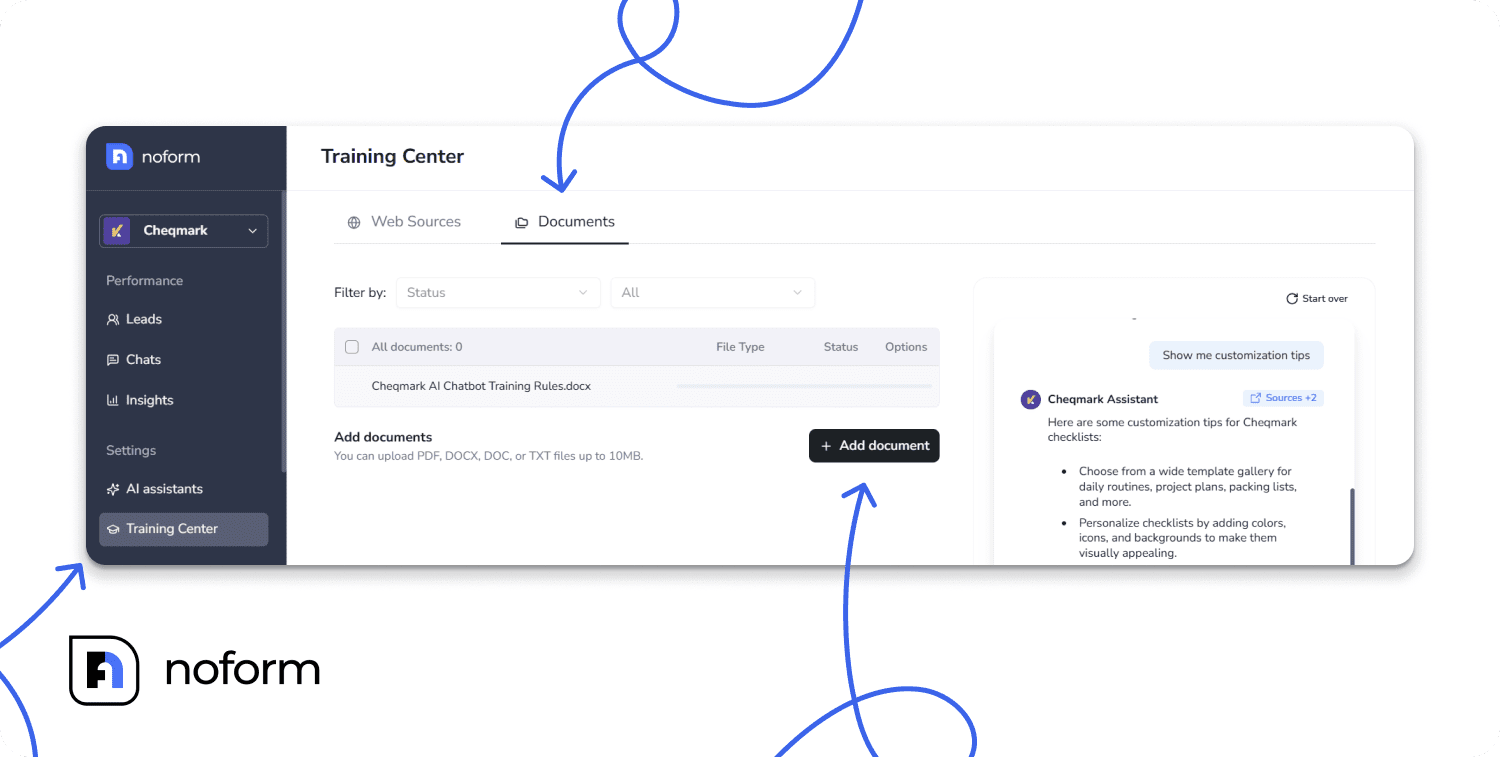
- Web pages and public URLs
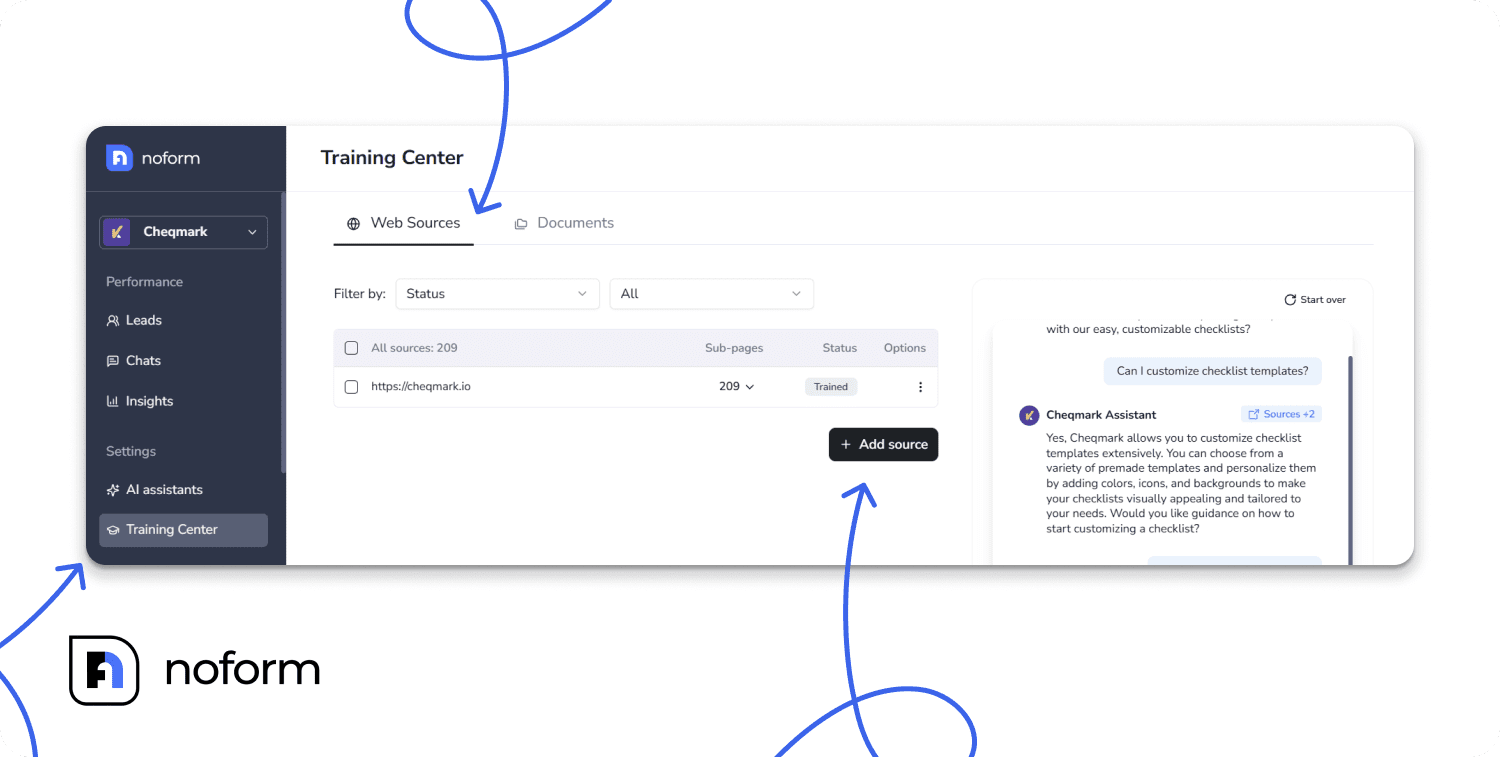
- Product guides, blogs, and internal notes
This content becomes the bot’s training dataset, helping it deliver accurate, relevant information. The platform automatically indexes your data so the chatbot can pull precise answers instantly.
2. Train your assistants
You can train one assistant to act as the foundation—or create several specialized versions, each with its own tone, purpose, and role. Every assistant draws from the same dataset, but custom-written instructions define how it communicates and what it focuses on.
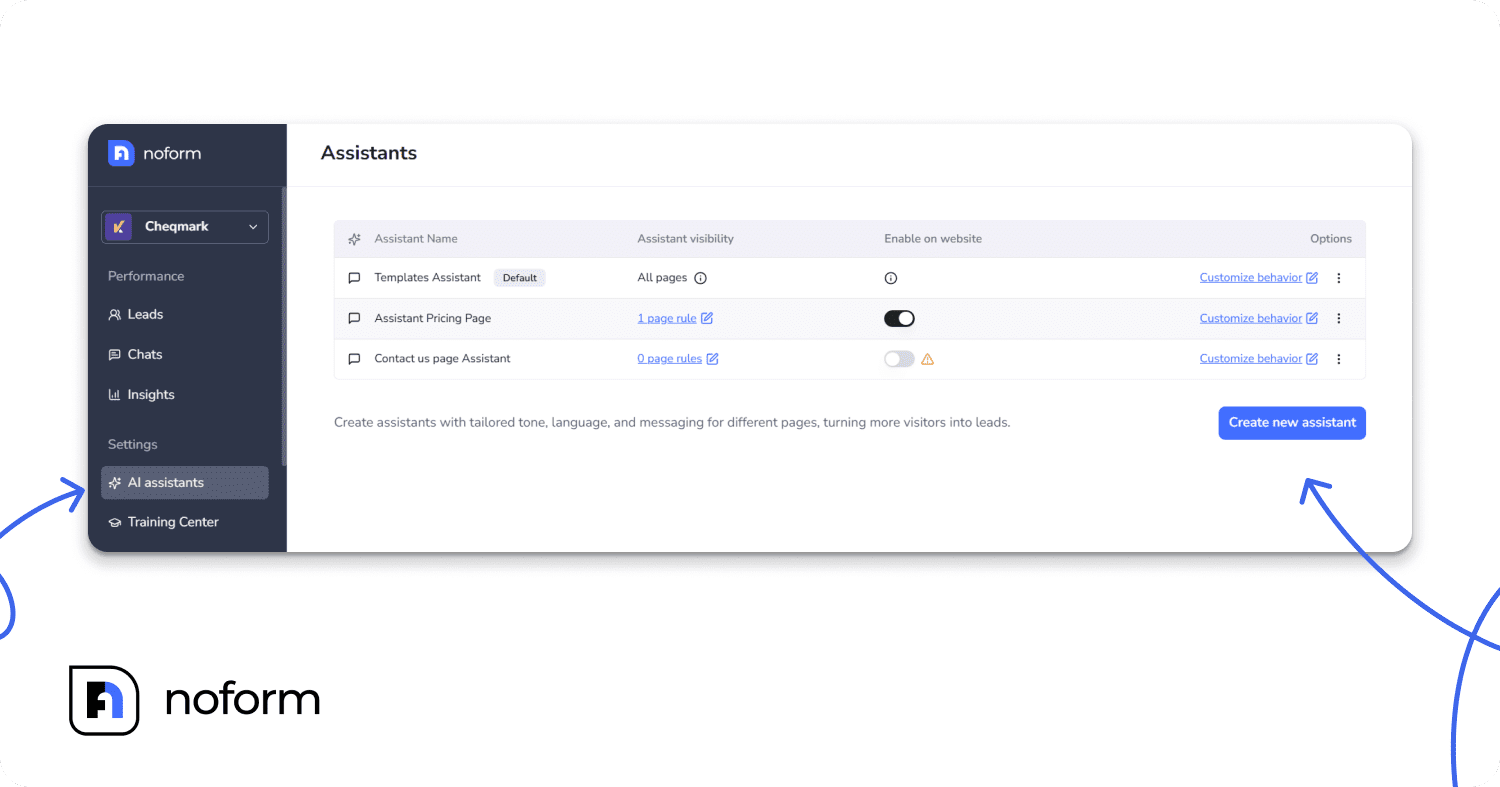
For example:
- On a pricing page, a Sales Assistant can address feature-specific questions, explain value, and share links to book demos (acquiring customers).
- On a blog post, an Educator Assistant can engage readers, highlight key takeaways, and strengthen your brand awareness campaign.
- On a support page, a Support Assistant can walk users through troubleshooting steps, answer FAQs, or hand off complex issues to a human.
This approach helps you reach your audience at every stage—sales, marketing, or support—without starting from scratch each time.
3. Test and refine based on conversations
Once you train and deploy your assistants, real user chats become a feedback loop. You can track how the bot responds, review low confidence thresholds, and fine-tune replies—all within the platform. No coding required.
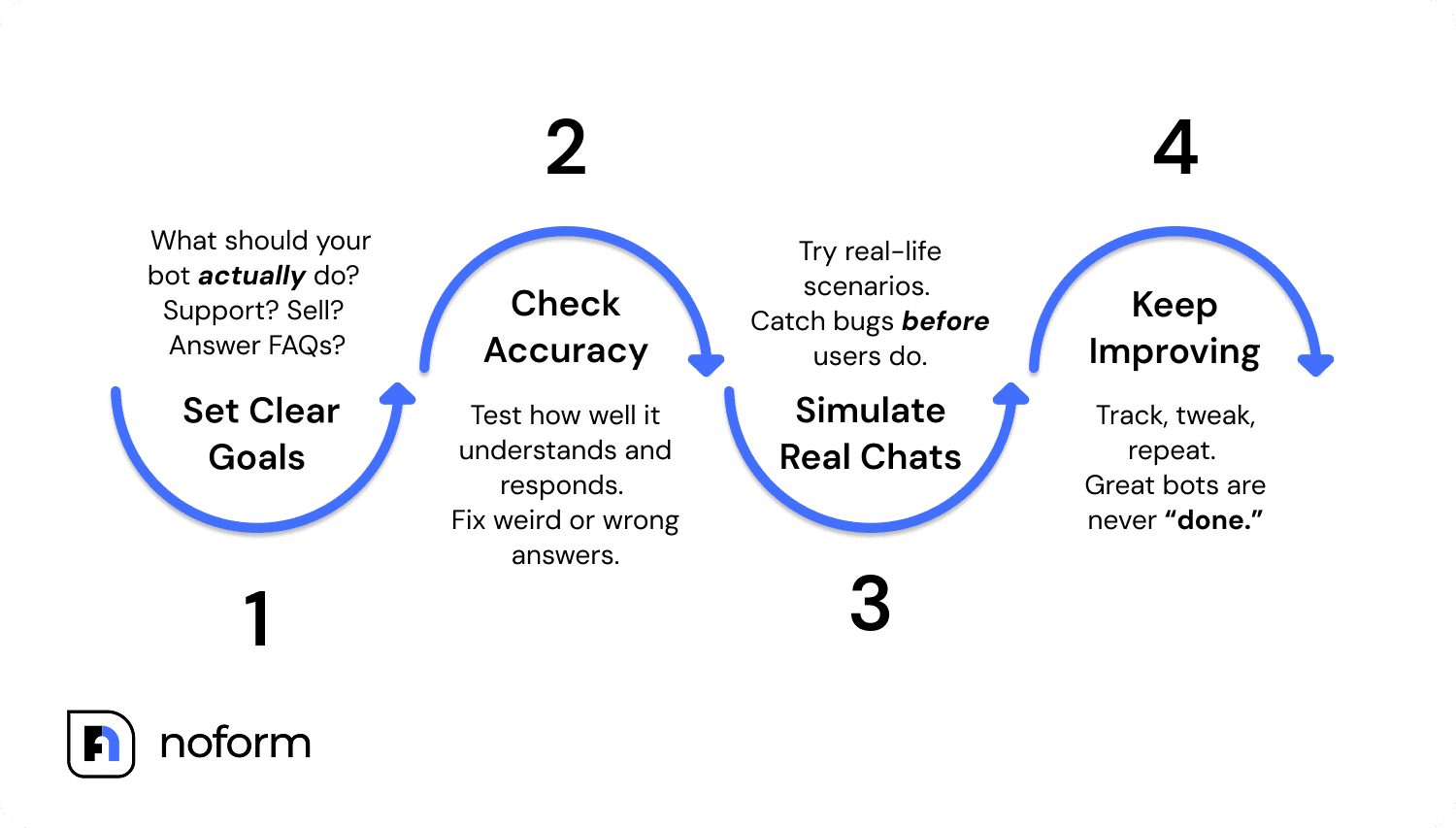
Tip: Learn more about chatbot testing in our article.
Best practices for effective chatbot training
No-code platforms like NoForm AI make AI chatbot training simple—even for non-technical teams.
Still, technology alone isn’t enough.
To get the most out of your training AI chatbot process, you’ll need to follow a few best practices that keep your model sharp, accurate, and aligned with your unique business goals.
Clean your data
Every good chatbot starts with clean input. Review your AI chatbot training data sources regularly and remove outdated, irrelevant, or duplicate content. Cluttered data leads to poor model predictions, so it’s worth taking the time to keep your dataset precise and trustworthy.
Tip: Schedule weekly or monthly sessions to review AI chatbot training data sources.
Organize your content
Structure matters. Group your FAQs, product information, and policy documents logically so the system can find context fast. Organized data helps your bot deliver consistent answers instead of guessing what fits.
Train for edge cases
Most users ask the same questions—but some won’t. Make sure to train AI for less common scenarios too. Preparing your bot for tricky input questions ensures smoother fallback interactions and fewer “I’m not sure” responses.
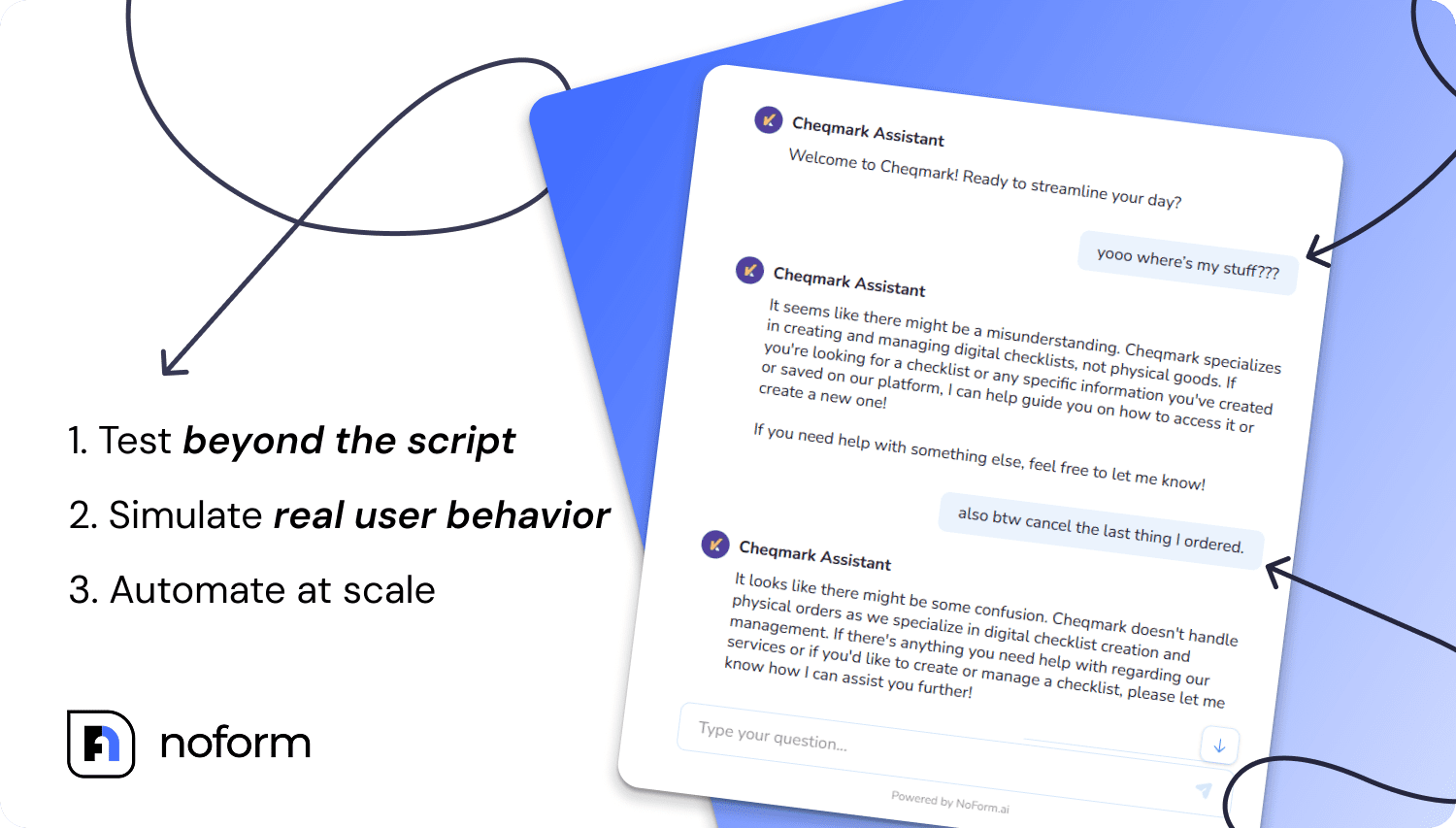
Keep formatting consistent
Use clear structures like Question–Answer when adding new data. Consistent formatting prevents confusion during model prediction and makes it easier to expand your custom GPT later.
Give it personality
People engage more when the chatbot feels human. Define a personality prompt that reflects your brand’s tone—friendly, professional, playful, or direct—and customize how the bot responds accordingly. A consistent voice builds trust and keeps users coming back.
Collaborate across teams
Don’t train in isolation. Involve marketing, sales and support teams in the bot training process. Employee engagement is vital as each team brings insights from their area—customer pain points, lead qualification patterns, or frequent objections—that improve overall accuracy.
Continuous training: Keeping the chatbot smarter over time
Since one of the best AI chatbot training practices is keeping your data clean and structured, the takeaway is clear: training never truly ends.
Even the most accurate model will drift if it isn’t maintained. Language shifts, products evolve, and customer expectations change. To preserve quality, treat chatbot training as a continuous system, not a one-time setup.
Here’s how to keep performance strong from day one—and every day after:
- Review analytics regularly: Track key metrics like the number of visitors on pages where an assistant is active, the visitor-to-chat conversion rate, total chats, chat-to-lead, and overall visitor-to-lead conversion rate. These insights show how effectively your assistants attract interactions, qualify leads, and support your business goals.
- Analyze conversation logs: Explore real chat histories to spot recurring misunderstandings or missed intents. This is your best source of truth. By updating or expanding your AI chatbot training data sources, you close gaps analytics alone can’t reveal.
- Use NoForm AI’s Training Center for refinement: The Training Center in NoForm AI lets you easily manage your assistant’s knowledge base. You can add or remove links and documents, then test how the assistant responds based on the updated content. For example, upload a new resource and immediately ask a related question to check the accuracy of its reply. This process helps ensure your assistant always provides up-to-date, relevant information without any coding or redeployment.
Common mistakes to avoid when training a chatbot
Just as there are proven methods for effective AI chatbot training, there are also missteps that can quietly undo your progress. Overlook these, and even a well-built chatbot for your business can end up underperforming, giving outdated answers, or missing the mark entirely. Staying aware of the most common pitfalls helps you start building a chatbot that stays accurate and aligned with your goals.
Here are the key mistakes to watch for—and how to prevent them:
Mistake | What happens | Fix it by… |
Neglecting updates | Treating chatbot training as a one-time task leads to outdated information and declining accuracy. | Build regular updates into your evaluation assignment schedule. Review content and refresh data frequently to keep information current. |
Training with insufficient or low-quality data | Weak or irrelevant datasets limit the bot’s ability to learn, resulting in generic or inaccurate replies. | Use clean, diverse, and verified AI chatbot training data sources. Expand them as your business grows and new questions appear. |
Failing to connect chatbot insights to the business strategy | Valuable user data gets ignored, and the bot’s potential to support marketing or sales is lost. | Review chatbot analytics to spot patterns and pain points, then use those insights to improve responses, update site messaging, and refine marketing and sales strategies. |
Ignoring tone, empathy, and multilingual support | A chatbot that sounds cold or struggles with non-English queries weakens user trust. | Test regularly for tone, empathy, and clarity. For multilingual sites, set up dedicated assistants per language—like a French Assistant for /fr/ pages—to keep conversations natural and accurate. |
Business impact of training AI chatbots
If there’s one takeaway from everything discussed so far, it’s that, beyond a technical task, AI chatbot training is a direct driver of business performance!
A well-trained chatbot using artificial intelligence strengthens marketing, sales, and customer service alike. With quality data and ongoing refinement, it evolves into a lasting business asset—not just a question-and-answer tool.
Here’s what effective chatbot training delivers:
- Faster response times: AI assistants reduce average response time dramatically by handling multiple messenger or web app queries at once.
- 24/7 lead generation and support: Always active, a chatbot captures leads and assists customers around the clock—no breaks, no missed opportunities. Thanks to this, NoForm AI’s client Dog Gone Taxi has boosted visitor-to-lead conversions by 37%.
- Improved customer satisfaction: A well-trained chatbot understands intent and context, providing accurate, friendly answers that make users feel heard and supported. According to research by Aberdeen, companies using AI solutions see a 3.5x greater improvement in customer satisfaction.
- Better customer engagement: Personalized, natural conversations keep visitors active longer and strengthen relationships across every channel. For example, after Cheqmark built a chatbot with NoForm AI, users explored more content and navigated the site more easily—resulting in a 67% increase in page views.
- Lower customer support costs: Automation handles repetitive questions, allowing teams to focus on higher-value work while keeping service costs in check.

Tip: Learn more about pros and cons of chatbots in our article!
How NoForm AI delivers value across the customer journey
The true power of trained AI emerges when it adapts to where customers are in their journey:
Funnel Stage | Visitor Context | NoForm AI’s Role | Business Outcome |
Awareness / Marketing | Reading blog posts, landing pages, or educational content | Engage visitors with relevant questions, share helpful resources, qualify intent, and capture lead information | Higher engagement rates, better lead quality, increased content effectiveness |
Consideration / Sales | Viewing product pages, pricing, or comparing solutions | Answer feature-specific questions, address objections, demonstrate value, and book qualified demos | Faster sales cycles, higher conversion rates, reduced sales team workload |
Retention / Service | Seeking support, troubleshooting, or exploring additional features | Provide instant answers to common issues, guide users to resources, escalate complex cases to human agents | Lower support costs, improved satisfaction, reduced churn |
Unlike generic chatbots that treat every visitor the same, NoForm AI uses training data to understand context and intent—delivering the right conversation at the right moment in the customer journey.
Summing up
A chatbot’s intelligence depends entirely on how well it’s trained. The quality of its data, structure, and feedback determines how accurately it understands users and delivers value. A strong training process turns a simple bot into a dependable, scalable part of your team.
Treat AI chatbot training as a continuous system that grows with your business. Regular updates and refinements keep it aligned with changing products, audiences, and goals—just like any high-performing employee.
Ready to see it in action? Book a demo call and try NoForm AI to experience how effective training creates chatbots that perform, adapt, and drive real results.
Frequently Asked Questions
How long does it take to train an AI chatbot?
With NoForm AI, training on your specific content (web pages and documents) is very fast, taking minutes to hours.
How much does it cost to train an AI chatbot?
With NoForm AI, there are no extra charges for training or uploading your data sources. Training is included as part of your overall platform subscription.
What data is needed to train a chatbot?
The chatbot is trained using your existing business content, which you provide by simply pasting website URLs or uploading documents (such as PDFs, DOCX, DOC, or TXT) that cover your product pages, service offerings & descriptions, FAQs, and any other business-specific information.
The more relevant and organized your content, the more accurate and helpful your chatbot will be.

